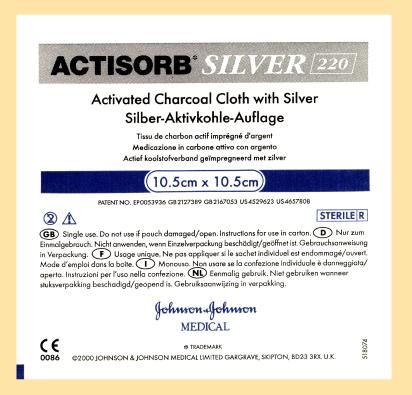
| Product Name: | Actisorb Silver 220 |
| Classification Name: | Dressing Activated Charcoal Cloth with Silver |
| Manufacturer: | Johnson & Johnson Medical Ltd |

Actisorb Silver 220 consists principally of activated carbon impregnated with metallic silver produced by a heating a specially treated fine viscose fabric under carefully controlled conditions. The carbonised fabric is enclosed in a sleeve of spun-bonded non-woven nylon, sealed along all four edges, to facilitate handling and reduce particle and fibre loss. When applied to a wound the dressing adsorbs toxins and wound degradation products as well as volatile amines and fatty acids responsible for the production of wound odour. Bacteria present in wound exudate are also attracted to the surface of the dressing where they are killed by the antimicrobial activity of the silver, which is active against a wide range of pathogenic organisms. This action is claimed to reduce the bacterial colonization of the wound and thus inhibit infection without the problems associated with the use of topical antibiotics or antiseptics.
Actisorb Silver 220 may be used in the treatment of most types of chronic wounds but is particularly recommended for the management of malodorous, infected wounds, including fungating lesions, faecal fistulae, infected pressure sores and heavily exuding leg ulcers.
Actisorb Silver 220 should not be used on patients who are sensitive to nylon, and should be used with care as a primary dressing on wounds that have a tendency to dry out. In these situations adherence of the dressing to the surface of the wound may become a problem.
The Actisorb Silver 220 may be applied directly to the wound surface and covered with a secondary dressing, held in position with tape or a bandage, as appropriate. The secondary dressing chosen will depend upon the nature of the wound, but in general, Tielle or a simple absorbent pad will be sufficient. It is also possible to use the dressing to gently pack open cavity wounds. If it is not considered appropriate to place Actisorb Silver 220 directly on to the wound the dressing may be placed between the selected wound contact material and the secondary dressing. The activity of the dressing will be greatly reduced if it is placed in contact with excess ointment or grease.
The frequency of dressing changes will depend entirely upon the nature and condition of the wound. Very heavily exuding or infected wounds may require that the dressing is changed daily initially, but as the wound becomes cleaner Actisorb Silver 220 may be left in place for up to 7 days although the outer absorbent layer may be changed more frequently if required.
Actisorb Silver 220 should be used in the intact state, and not cut to shape prior to application to the wound.
Actisorb Silver 220 is presented in a peel pouch, sterilised by gamma irradiation.
1. Mulligan, C. M., Bragg, A. J. D., O'Toole, O. B. A controlled comparative trial of Actisorb activated charcoal cloth dressings in the community. British Journal of Clinical Practice 1986; 9(1): 145-148.
2. Wunderlich, U., Orfanos, C. E. Treatment of venous ulcera cruris with dry wound dressings. Phase overlapping use of silver impregnated activated charcoal xerodressing. Hautarzt 1991; 42(7): 446-450.
3. Russell, A. D., Hugo, W. B. Antimicrobial activity and action of silver. In: Ellis GP, Luscombe DK, editors. Progress in Medicinal Chemistry: Elsevier Science, 1994:351-369.
4. Rudolph, P., Werner, H.-P., Kramer, A. Studies on the microbicidal efficacy of wound dressings. Hygiene + Medizin 2000; 25(5): 184-186.
Further information on obtaining
Johnson & Johnson
products is available on the
Johnson & Johnson
web site.
| Revision Author | Dr S. Thomas |
| Revision No | 1.1 |
| Revision date | 2002/01/29 |
This datacard has been prepared from data provided by the manufacturer and/or from published literature.